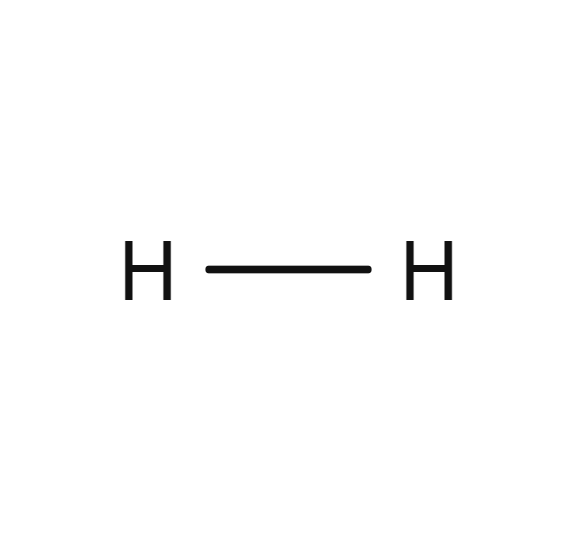
para-Hydrogen
- p-H2
- CAS Number 1333-74-0
- UN1049 (gas)
- UN1966 (refrigerated liquid)
Click & drag to move the 3D molecule
Liquid / Gas Volumes
Calculate the volume or mass of a quantity of gas or liquid
Liquid Phase
At boiling point at 1.013 bar
Gas Phase
In standard conditions (1.013 bar, 15°C)
Physical Properties
Molecule phase diagram showing the transition phases between solid, liquid and gas as a function of temperature and pressure
-
- Molar mass 2.016 g/mol
- Content in dry air /
-
Critical Point
- Temperature -240.17 °C
- Pressure 12.928 bar
- Density 31.43 kg/m³
-
Triple Point
- Temperature -259.35 °C
- Pressure 7.0077E-2 bar
Pressure 1.013 bar
| Latent heat of fusion (at melting point) | 58.287 kJ/kg |
| Melting point | - 259.35 °C |
Pressure 1.013 bar
| Boiling point | - 252.88 °C |
| Latent heat of vaporization (at boiling point) | 446.06 kJ/kg |
| Liquid density (at boiling point) | 70.832 kg/m3 |
| Compressibility factor Z | 1.0006 |
| Cp/Cv ratio γ | 1.3775 |
| Gas density (at boiling point) | 1.338 kg/m3 |
| Gas density | 8.99E-2 kg/m3 |
| Gas/(liquid at boiling point) equivalent | 788.22 vol/vol |
| Heat capacity Cp | 15.0608 kJ/(kg.K) |
| Heat capacity Cv | 10.9341 kJ/(kg.K) |
| Specific gravity | 0.07 |
| Specific volume | 11.128 m3/kg |
| Thermal conductivity | 182.44 mW/(m.K) |
| Viscosity | 8.3969E-5 Po |
| Compressibility factor Z | 1.0006 |
| Cp/Cv ratio γ | 1.382 |
| Gas density | 8.52E-2 kg/m3 |
| Gas/(liquid at boiling point) equivalent | 831.49 vol/vol |
| Heat capacity Cp | 14.9298 kJ/(kg.K) |
| Heat capacity Cv | 10.8031 kJ/(kg.K) |
| Specific gravity | 0.07 |
| Specific volume | 11.739 m3/kg |
| Thermal conductivity | 187.89 mW/(m.K) |
| Viscosity | 8.7098E-5 Po |
| Compressibility factor Z | 1.0006 |
| Cp/Cv ratio γ | 1.3845 |
| Gas density | 8.23E-2 kg/m3 |
| Gas/(liquid at boiling point) equivalent | 860.34 vol/vol |
| Heat capacity Cp | 14.8574 kJ/(kg.K) |
| Heat capacity Cv | 10.7312 kJ/(kg.K) |
| Specific gravity | 0.07 |
| Specific volume | 12.146 m3/kg |
| Thermal conductivity | 191.58 mW/(m.K) |
| Viscosity | 8.9154E-5 Po |
Applications
Examples of uses of this molecule in Industry and Healthcare
Safety & Compatibility
Autoignition Temperature, Flammability Limits & Flash Point
US (according to ASTM E681 for Limits and ASTM E659 for autoignition temperature)
| Autoignition temperature (NFPA 325) | 500 °C |
| Lower flammability limit (NFPA 325) | 4 vol% |
| Upper flammability limit (NFPA 325) | 75 vol% |
Metals
| Aluminium | No data |
| Brass | No data |
| Monel | No data |
| Copper | No data |
| Ferritic Steel | No data |
| Stainless steel | No data |
| Zinc | No data |
| Titanium | No data |
Plastics
| Polytetrafluoroethylene | No data |
| Polychlorotrifluoroethylene | No data |
| Polyvinylidene fluoride | No data |
| Polyvinyl chloride | No data |
| Ethylene tetrafluoroethylene | No data |
| Polycarbonate | No data |
| Polyamide | No data |
| Polypropylene | No data |
Elastomers
| Butyl (isobutene- isoprene) rubber | No data |
| Nitrile rubber | No data |
| Chloroprene | No data |
| Chlorofluorocarbons | No data |
| Silicone | No data |
| Perfluoroelastomers | No data |
| Fluoroelastomers | No data |
| Neoprene | No data |
| Polyurethane | No data |
| Ethylene-Propylene | No data |
Lubricants
| Hydrocarbon based lubricant | No data |
| Fluorocarbon based lubricant | No data |
Materials compatibility
Recommendations : Air Liquide has gathered data on the compatibility of gases with materials to assist you in evaluating which materials to use for a gas system. Although the information has been compiled from what Air Liquide believes are reliable sources (International Standards: Compatibility of cylinder and valve materials with gas content; Part 1- Metallic materials: ISO11114-1 (March 2012), Part 2 - Non-metallic materials: ISO11114-2 (April 2013), it must be used with extreme caution and engineering judgement. No raw data such as these can cover all conditions of concentration, temperature, humidity, impurities and aeration. It is therefore recommended that this table is only used to identify possible materials for applications at high pressure and ambient temperature. Extensive investigation and testing under the specific conditions of use need to be carried out to validate a material selection for a given application. Contact the regional Air Liquide team for expertise service.